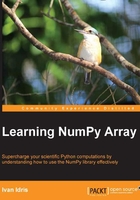
What this book covers
Chapter 1, Getting Started with NumPy, will guide you through the steps needed to install NumPy on your system and helps you create a basic NumPy application. We also successfully run a vector addition program.
Chapter 2, NumPy Basics, introduces you to NumPy arrays and fundamentals. In this chapter, we also learn that NumPy arrays can be sliced and indexed in an efficient manner. Here, we will understand the manipulation of shapes of various arrays.
Chapter 3, Basic Data Analysis with NumPy, tells us about learning data analysis with weather data analysis as an example. We will also explore the data from a KNMI weather station.
Chapter 4, Simple Predictive Analytics with NumPy, helps us attempt to predict the weather with simple models, such as Autoregressive Model with Lag 1 and Autoregressive Model with Lag 2.
Chapter 5, Signal Processing Techniques, gives us examples of signal processing and time series analysis. We look at smoothing with window functions and moving averages. We also touch upon the sifting process used by scientists to derive sunspot cycles. And we also get a demonstration of cointegration.
Chapter 6, Profiling, Debugging, and Testing, is about profiling, debugging, and testing, which are essential phases in the development cycle. We also cover unit testing, assert functions, and floating-point precision in depth.
Chapter 7, The Scientific Python Ecosystem, gives an overview of the Python ecosystem in which NumPy takes a central role. We also examine Cython, which is a relatively young programming language based on Python. We also have a look at Clustering, a type of machine learning algorithm.